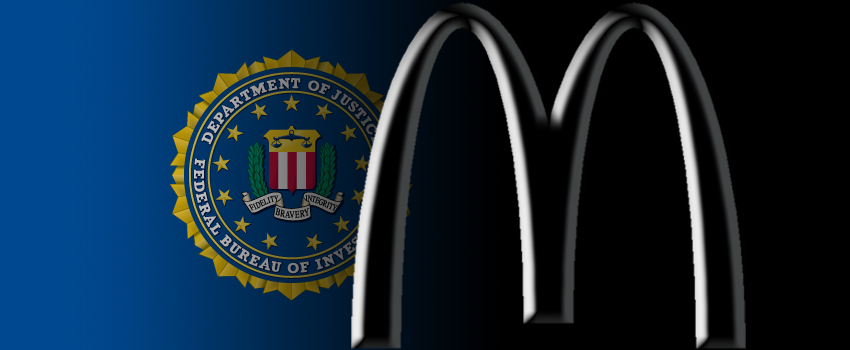Correcting Probability Misconceptions in McDonald’s Promotion: An FBI Briefing
 Click on this link to visualize the original email: 2023-02-06_1840_0800_fbi_quite_important.pdf
Click on this link to visualize the original email: 2023-02-06_1840_0800_fbi_quite_important.pdf
From:
Vincent Le Corre
Subject: Quite important
Date sent: February 06, 2023, 18:40 +0800 (China Standard Time)
To:
Adam Rogalski (Legal Attaché/State Department),
Federal Bureau of Investigation (FBI),
Edward Lehman
Note: since Assistant Legal Attaché Adam Rogalski told me on 2021-09-20 that he was “one of the FBI representatives,” I assume that this communication was transferred to the
Federal Bureau of Investigation (FBI).
Dear Messrs. Rogalski and Lehman,
This is the article written by Walter Hickey which contains at least 2 major mistakes:
https://www.businessinsider.com/math-mcdonalds-monopoly-odds-probability-2013-7
It was written in 2013, about one year after Mr. Hickey got his degree in applied mathematics. That’s why I want to try to find a polite way to ask him and Business insider to correct this deeply flawed article.
The main part he got right is when he says:
“[…] But let’s get to the real fun.
Collect and Win Monopoly
Here’s the secret to McDonald’s Monopoly.
Many people assume that all the spaces are equally likely. […]”
Yep, I agree. But be very careful, when he says: “For instance, most people think if McDonald’s wants the Brown prize probability to be 1 in 1,000,000, they’ll make the probability of drawing Baltic 1 in 1,000 and Mediterranean 1 in 1,000, making the probability of getting both 1 in 1,000,000.” it’s totally wrong and unfeasible but this part is not very important but I still want them to correct it. Consumers believe in reality that if there are 26 different properties, they have 1 chance out of 26.
PAY ATTENTION PLEASE:
The article states:
- “There are approximately 602,490,060 game pieces in play.
- This means that there are 1.2 billion game stamps, or individual attempts at victory.
- There are 135,540,995 food prizes
- There are 15,838,729 instant win prizes.
- The odds of winning a prize at the in-store game are 1 in 4, or a 25% probability.”
Messrs. Rogalski and Lehman, this part is very important:
Here is the definition David Morin gives of “the probability of a certain scenario happening” (see last email I sent you):
p = (number of desired outcomes) / (total number of possible outcomes)
Remember that an element and a set are different things, even though “It is important to know that a set itself may also be an element of some other set.” (Naive Set Theory by Paul R. Halmos)
What defines whether a customer wins or not? It’s an instant-win game stamp (an element). And a game piece (a set) has 2 games stamps in it (2 elements).
WRONG: p = elements / sets
WRONG: p = number of instant-win elements / total number of possible sets
CORRECT ANSWER: p = number of instant-win elements / total number of elements
CORRECT ANSWER: p = (135,540,995 + 15,838,729) / (“1.2 billion game stamps, or individual attempts at victory”)
I just realized that even the author of the article admits that game stamps are “individual attempts at victory”.
135540995 + 15838729 = 151379724
602490060 x 2 = 1204980120
CORRECT ANSWER: p = 151379724 / 1204980120
CORRECT ANSWER: p ≈ 1 / 8
It’s fraud.
It’s not even a half truth because McDonald’s fraudulently first claim 1 chance out of 4.
Then, the fine print NEVER mentions its 1 chance out of 8. In France, for the year 2011, they stated 1 chance out of 2.
https://www.tojournalists.com/open-letters/explanations-sent-to-constant-meheut-may-25-2022/
In the U.S., for the year 2011, if I am not mistaken and my calculations are correct, and based on how McDonald’s will defend itself, they stated either 1 chance out of 4 or it could be interpreted as a binomial distribution with 4 trials and a probability of 0.25, or it could be interpreted as a binomial distribution with 4 trials and the probability of winning at each trial is deliberately missing, it’s exceptionally cunning, truly I tell you, the work of the devil.
WHAT I EXPLAIN BELOW, YOU DON’T NEED TO UNDERSTAND LIKE RIGHT AWAY, BUT SOONER OR LATER, WITHIN 1 to 2 weeks, the FBI agents and/or U.S. Attorney(s) should better understand:
In 2013 and/or 2016, when McDonald’s claims the odds are based on game pieces each game piece has 2 game stamps, what does McDOnald’s mean to say exactly? That the calculation is based on a binomial distribution? Because if we start calculating on a multiple trials/attemps, then, we also need to know what’s the probability per attempt. Is it 0.25? Or is it something else?
You see, for the year 2011, the year LeBron James promoted the fraud, it was written it’s based on 2 games pieces (each game piece has 2 game stamps), so 4 game stamps totally, if and only if we interpret the meaning of the parentheses from a mathematical point of view and not necessarily from a English language point of view! ! !
But for the year 2011, when I enter this entry in Wolfram Alpha Notebook Edition (https://www.wolfram.com):
BinomialDistribution[4,0.25], it yields the following results: Probability results […] “at least one success 68.36%” (4 = number of trials and 0.25 is the probability of success (McDonald’s claims 1 chance out of 4 or 0.25)).
OR did McDonald’s mean, for the year 2011, that the binomial distribution, had the following input:
Number of trials: 4
Probability of success: 0.125 (or 1 chance out of 8)
Which then yields the following results:
“BinomialDistribution[4,0.125]” “at least one success 41.38%”
But please remember always remember what I explain to New York Times journalist Constant Méheut:
https://www.tojournalists.com/open-letters/explanations-sent-to-constant-meheut-may-25-2022/
For the year 2013 and 2016, for the United States, I think it’s fair to say that McDonald’s claim in the fine print that consumers have 50% of chance to win instantly. If the basis of their calculation are 2 game stamps (2 elements), then, at least, and at most, 1 of the 2 elements must be a winning game stamp which means 1 chance out of 2.
All of this might seem complex and confusing because McDonald’s committed an extremely vicious and cunning fraud.
ALWAYS REMEMBER THAT CHILDREN 13 YEARS AND OLDER WERE SUPPOSED TO UNDERSTAND ALL OF THIS! ! ! IT’S IMPOSSIBLE ! ! !
Click on this link to visualize the original email: 2023-02-06_1840_0800_fbi_quite_important.pdfTo gain a clearer understanding of the sequence of events in this case, I invite you to view a detailed timeline at the following link:
https://www.ECTHRwatch.org/timeline/mcdonalds/
This timeline provides a comprehensive overview of the key milestones and developments.
